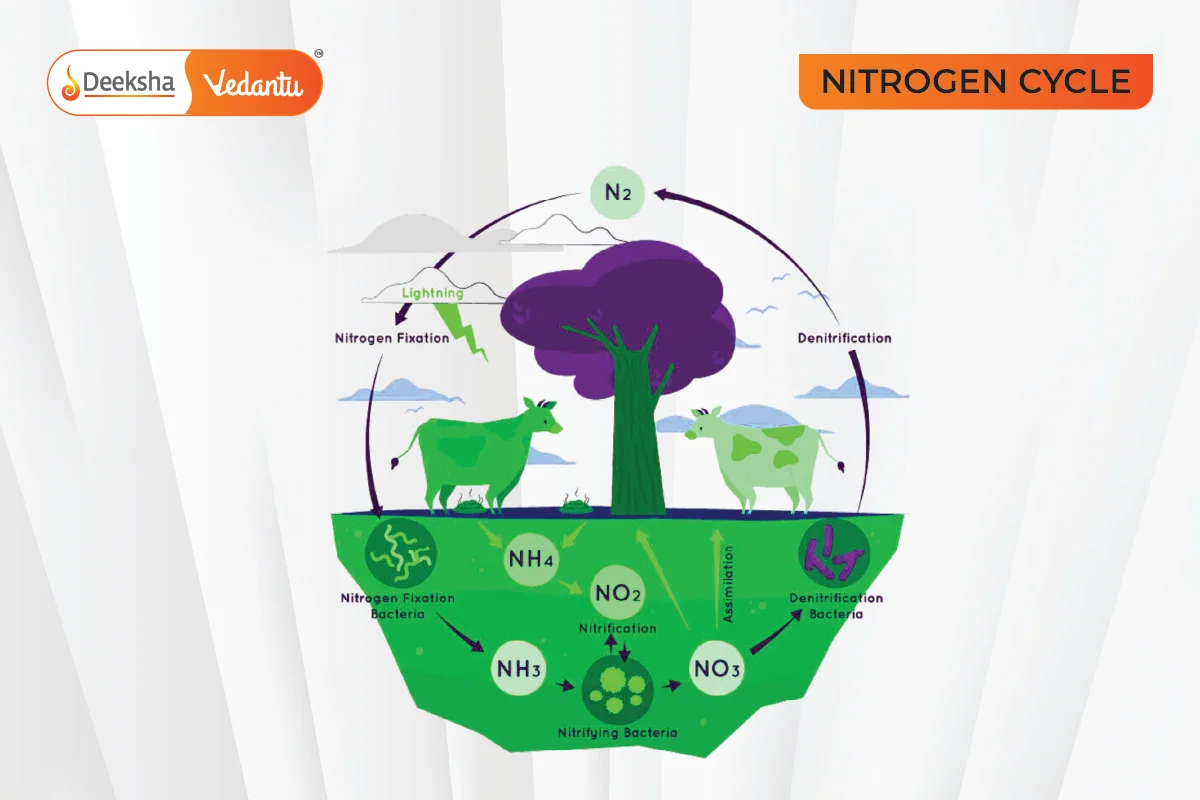Understanding the Nitrogen Cycle
The nitrogen cycle is an essential biogeochemical process that ensures the continuous exchange of nitrogen among the atmosphere, the land, and living organisms. Nitrogen is a vital element for all living organisms as it forms the backbone of crucial biological molecules such as proteins, DNA, and RNA. However, despite its abundance in the atmosphere (around 78% of Earth’s air), most organisms cannot directly use atmospheric nitrogen in its gaseous form.

Nitrogen Cycle Definition:
The nitrogen cycle is a series of processes by which nitrogen and its compounds are interconverted in the environment and in living organisms, including nitrogen fixation and decomposition.
Key Processes in the Nitrogen Cycle:
- Nitrogen Fixation: Conversion of atmospheric nitrogen into compounds like ammonia, some of which is done by atmospheric processes such as lightning, but most is performed by nitrogen-fixing bacteria found in the soil or in plant roots.
- Nitrification: This involves the conversion of ammonia into nitrite and then to nitrate, which plants can absorb as nutrients.
- Assimilation: Plants absorb nitrates from the soil, which are then used to synthesize new organic molecules like amino acids.
- Ammonification: Decomposition of organic nitrogen back into ammonia by decomposer organisms, which then reenters the soil.
- Denitrification: Conversion of soil nitrates into nitrogen gas, which returns to the atmosphere, completing the cycle.
Importance of the Nitrogen Cycle:
- For Agriculture: It helps in understanding the role of nitrogen in plant nutrition and improves the efficiency of fertilizers.
- Ecological Balance: Plays a crucial role in maintaining the ecosystem balance by recycling nitrogenous wastes.
- Environmental Impact: Helps in understanding and managing the impacts of excess nitrogen in terrestrial and aquatic ecosystems.
Nitrogen Cycle’s Impact on the Environment
The nitrogen cycle is critical for maintaining the health of our ecosystems but can be disrupted by human activities such as agriculture, which introduces large amounts of nitrogen into the soil and water through fertilizers. This excess nitrogen can lead to eutrophication in aquatic systems, leading to the death of fish and other aquatic life due to lack of oxygen. Furthermore, the release of nitrogen oxides during combustion processes contributes to air pollution and acid rain, which can harm ecosystems and human health.
Conclusion
The nitrogen cycle describes the path that nitrogen takes from its most abundant form in the atmosphere to various biologically useful forms and back. Understanding this cycle is essential not just for biology and ecology but also for environmental management and agriculture. Efforts to manage nitrogen pollution require a deep understanding of the nitrogen cycle to create effective strategies for sustainable development.
FAQs
Effective management of the nitrogen cycle involves practices like precision farming, using nitrogen-fixing crops to naturally enrich the soil, and regulating the use of nitrogenous fertilizers to prevent excess runoff. These practices help maintain ecological balance and reduce pollution.
The nitrogen cycle impacts the environment significantly, particularly through the leaching and runoff of excess nitrogen from agricultural fields into waterways, which can lead to eutrophication and the disruption of aquatic ecosystems. Additionally, nitrogen oxides from industrial processes contribute to air pollution and acid rain.
Nitrogen fixation is the process by which atmospheric nitrogen is converted into a form that plants can use, such as ammonia. This process is primarily carried out by symbiotic bacteria known as diazotrophs, which include genera like Rhizobium in leguminous plants.
Plants primarily obtain nitrogen through the soil in the form of nitrates and ammonium ions, which they absorb through their roots. These forms of nitrogen are made available through the process of nitrification and nitrogen fixation by bacteria.
Nitrogen is a vital component of amino acids, proteins, and nucleic acids, which are essential for the growth and function of all living organisms. It is a fundamental building block of life.
The nitrogen cycle is a biogeochemical cycle that transforms nitrogen and its compounds through various environmental and biological processes, including fixation, nitrification, and denitrification, making it usable for living organisms.
Related Topics
- Air Pollution Control
- Human Respiratory System
- Ozone Layer and its Depletion
- Overview of Food Chain
- Heredity Traits
- Prokaryotic and Eukaryotic Cells
- Modes Of Reproduction Used By Single Organisms
- Eco-System – What Are Its Components?
- What Are Life Processes?
- Do Organisms Create Exact Copies of Themselves?
- Human Heart
- Plant Cell
- Ecosystem
- Our Environment
- Human Digestive System











Get Social